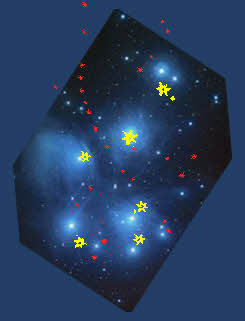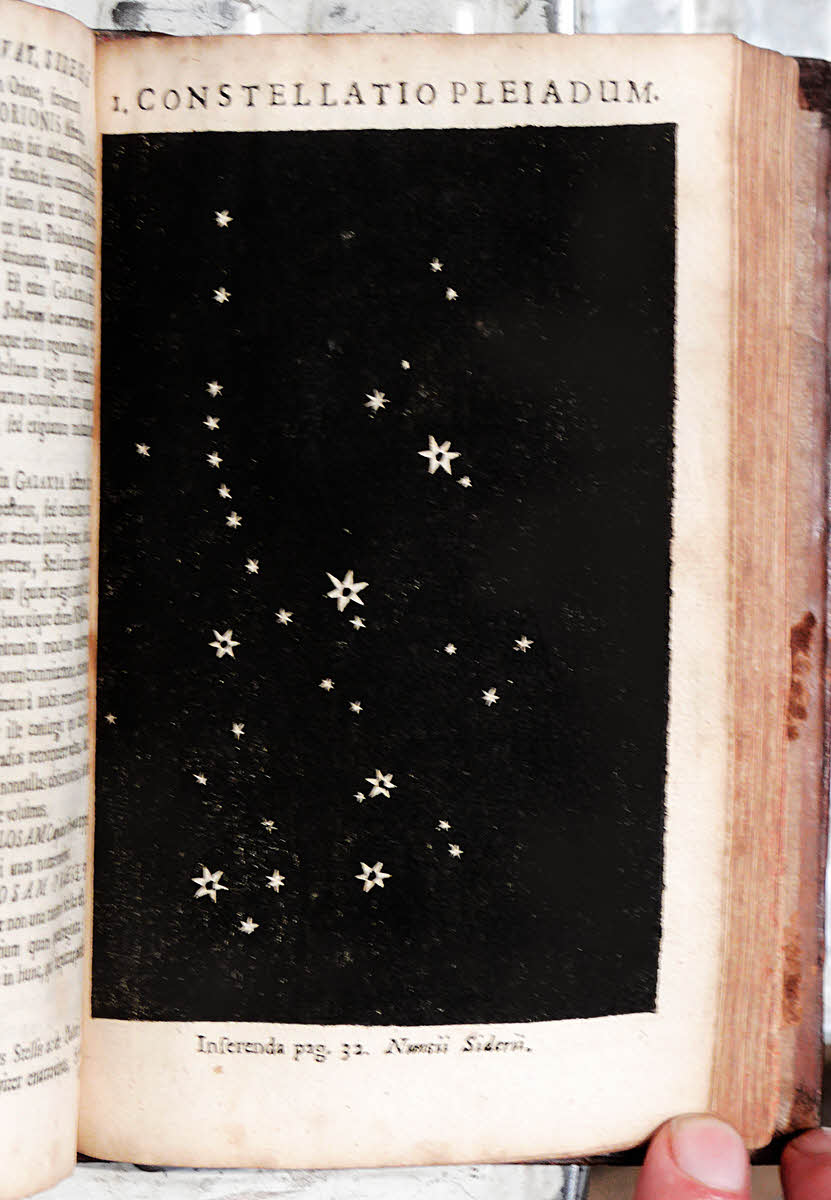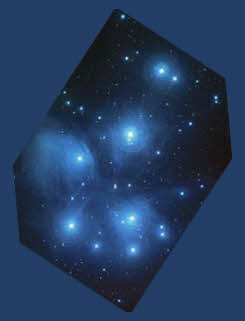
 Bookmark this on Delicious
Bookmark this on Delicious
 Recommend toStumbleUpon
Recommend toStumbleUpon
Flat Earth Academy offers a more general page about finding stuff in the sky over your head. This page concentrates on the Pleiades.
The image on the left below comes from the first work of Galileo published in England, the Sidereus Nuncius. (First published in Venice in 1610.) It is Galileo's drawing of the star cluster called the Pleiades. Galileo's book was the first with observations based on things seen through a telescope. In the same book he tells the world about Jupiter's moons. Important because that was a system where things were not going around the earth, as the people who were getting their world view from the church "knew" things had to be. Again in the same book, he makes hitherto unrivaled observations on the moon, and deduces the topography of craters from the way shadows wax and wane as the terminator moves.
I hope in due course to expand these fragments about astronomy into a page illustrating the history of what we have been able to see, and challenging readers to see how well they can do, with the naked eye, with relatively inexpensive binoculars, and with whatever telescopes they can access.
My image of the page of Galileo has been tweaked slightly to somewhat darken the bits that are meant to be solid black... the printer's ink had not covered the block perfectly.
The image on the right, from the Digitized Sky Survey, by NASA/ESA/AURA/Caltech, shows a modern image of the same stars.


And finally, here are the two overlaid, with Galileo's stars in red and yellow, yellow for the six more bright stars, plus the little one near the upper bright star, which (along with other less bright stars) Galileo clearly got right. Before you scoff at the "inaccuracy" of Galileo's diagram, try one of your own with, say, good binoculars. Or even just try to sketch the modern image you see on the screen.. by hand, on tracing paper, and then see how well your map matches NASA's by holding the tracing paper to your screen, and resizing the window as necessary. And Galileo was working mostly in the dark, to preserve his night vision for the telescope, wasn't he?

(A generic footer used across many of the Flat Earth Academy pages begins here.)
Have you heard of Flattr? Great new idea to make it easy for you to send small thank you$ to people who provide Good Stuff on the web. If you want to send $$erious thank yous, there are better ways, but for a small "tip" here and there, Flattr ticks a lot of boxes which no one else has found a way to do yet. Please at least check out my introduction to Flattr, if you haven't heard of it? "No obligation", as they say!
Search across all my sites with the Google search button at the top of the page the link will take you to.
Or...
Search just this site without using forms,
Or... again to search just this site, use...
The search engine merely looks for the words you type, so....
*! Spell them properly !*
Don't bother with "How do I get rich?" That will merely return pages with "how", "do", "I", "get" and "rich".
I have other sites. My Google custom search button will include things from them....
One of my SheepdogGuides pages.
My site at Arunet.
This page's editor, Tom Boyd, will be pleased if you get in touch by email.
![]() Page qWILL BE tested for compliance with INDUSTRY (not MS-only) standards, using the free, publicly accessible validator at validator.w3.org. Mostly passes. There were two "unknown attributes" in Google+ button code, two further "wrong" things in the Google Translate code, and similar in Flattr code. Sigh.
Page qWILL BE tested for compliance with INDUSTRY (not MS-only) standards, using the free, publicly accessible validator at validator.w3.org. Mostly passes. There were two "unknown attributes" in Google+ button code, two further "wrong" things in the Google Translate code, and similar in Flattr code. Sigh.